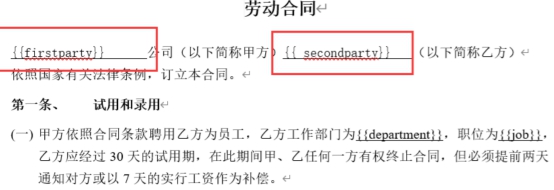利用python怎么实现一个生成word合同功能?相信很多没有经验的人对此束手无策,为此本文总结了问题出现的原因和解决方法,通过这篇文章希望你能解决这个问题。
1、模板文件
甲方公司、乙方人员姓名、乙方部门、乙方职位、甲方人员姓名、乙方人员姓名、时间(年月日),如图所示。

2、实现代码
from docxtpl import DocxTemplate import os import pymysql import time cur_path = os.path.dirname(__file__) tempfilename = os.path.join(cur_path, 'template', '劳动合同模板.docx') today = time.strftime("%Y-%m-%d", time.localtime()) def query(): try: # 数据库连接,返回数据库连接对象 conn = pymysql.connect(host='localhost', user='root', passwd='123456', db='test', port=3306) cur = conn.cursor() sql = 'select * from t_person_info' cur.execute(sql) result = cur.fetchall() return result except Exception as e: print(e) finally: conn.close() def build_hetong(): result = query() for x in result: tpl = DocxTemplate(tempfilename) context = { 'firstparty': '灯塔教育', 'secondparty': x[1], 'department': x[15], 'job': x[16], 'owner': '龙卷风', 'name': x[1], 'sj': today } tpl.render(context) savefilename=os.path.join(cur_path,'build',x[1]+'劳动合同.docx') tpl.save(savefilename) if __name__ == "__main__": start = time.time() build_hetong() end = time.time() sj = end-start print(f"花费时间(秒):{sj}")实例扩展(批量WORD合同生成)
导入数据库
#导入对应数据库 import numpy as np import pandas as pd import os import docx from docx.shared import Pt from docx.oxml.ns import qn #修改项目文件地址 os.chdir(r'C:\Users\WIN7\Desktop\分期账单自动化') os.getcwd()全部代码:
''' 人民币数字转大写汉字 ''' # coding: utf-8 import warnings from decimal import Decimal def cncurrency(value, capital=True, prefix=False, classical=None): ''' 参数: capital: True 大写汉字金额 False 一般汉字金额 classical: True 元 False 圆 prefix: True 以'人民币'开头 False, 无开头 ''' if not isinstance(value, (Decimal, str, int)): msg = ''' 由于浮点数精度问题,请考虑使用字符串,或者 decimal.Decimal 类。 因使用浮点数造成误差而带来的可能风险和损失作者概不负责。 ''' warnings.warn(msg, UserWarning) # 默认大写金额用圆,一般汉字金额用元 if classical is None: classical = True if capital else False # 汉字金额前缀 if prefix is True: prefix = '人民币' else: prefix = '' # 汉字金额字符定义 dunit = ('角', '分') if capital: num = ('零', '壹', '贰', '叁', '肆', '伍', '陆', '柒', '捌', '玖') iunit = [None, '拾', '佰', '仟', '万', '拾', '佰', '仟','亿', '拾', '佰', '仟', '万', '拾', '佰', '仟'] else: num = ('〇', '一', '二', '三', '四', '五', '六', '七', '八', '九') iunit = [None, '十', '百', '千', '万', '十', '百', '千','亿', '十', '百', '千', '万', '十', '百', '千'] if classical: iunit[0] = '元' if classical else '圆' # 转换为Decimal,并截断多余小数 if not isinstance(value, Decimal): value = Decimal(value).quantize(Decimal('0.01')) # 处理负数 if value < 0: prefix += '负' # 输出前缀,加负 value = - value # 取正数部分,无须过多考虑正负数舍入 # assert - value + value == 0 # 转化为字符串 s = str(value) if len(s) > 19: raise ValueError('金额太大了,不知道该怎么表达。') istr, dstr = s.split('.') # 小数部分和整数部分分别处理 istr = istr[::-1] # 翻转整数部分字符串 so = [] # 用于记录转换结果 # 零 if value == 0: return prefix + num[0] + iunit[0] haszero = False # 用于标记零的使用 if dstr == '00': haszero = True # 如果无小数部分,则标记加过零,避免出现“圆零整” # 处理小数部分 # 分 if dstr[1] != '0': so.append(dunit[1]) so.append(num[int(dstr[1])]) else: so.append('整') # 无分,则加“整” # 角 if dstr[0] != '0': so.append(dunit[0]) so.append(num[int(dstr[0])]) elif dstr[1] != '0': so.append(num[0]) # 无角有分,添加“零” haszero = True # 标记加过零了 # 无整数部分 if istr == '0': if haszero: # 既然无整数部分,那么去掉角位置上的零 so.pop() so.append(prefix) # 加前缀 so.reverse() # 翻转 return ''.join(so) # 处理整数部分 for i, n in enumerate(istr): n = int(n) if i % 4 == 0: # 在圆、万、亿等位上,即使是零,也必须有单位 if i == 8 and so[-1] == iunit[4]: # 亿和万之间全部为零的情况 so.pop() # 去掉万 so.append(iunit[i]) if n == 0: # 处理这些位上为零的情况 if not haszero: # 如果以前没有加过零 so.insert(-1, num[0]) # 则在单位后面加零 haszero = True # 标记加过零了 else: # 处理不为零的情况 so.append(num[n]) haszero = False # 重新开始标记加零的情况 else: # 在其他位置上 if n != 0: # 不为零的情况 so.append(iunit[i]) so.append(num[n]) haszero = False # 重新开始标记加零的情况 else: # 处理为零的情况 if not haszero: # 如果以前没有加过零 so.append(num[0]) haszero = True # 最终结果 so.append(prefix) so.reverse() return ''.join(so)郑重声明:本文版权归原作者所有,转载文章仅为传播更多信息之目的,如作者信息标记有误,请第一时间联系我们修改或删除,多谢。
